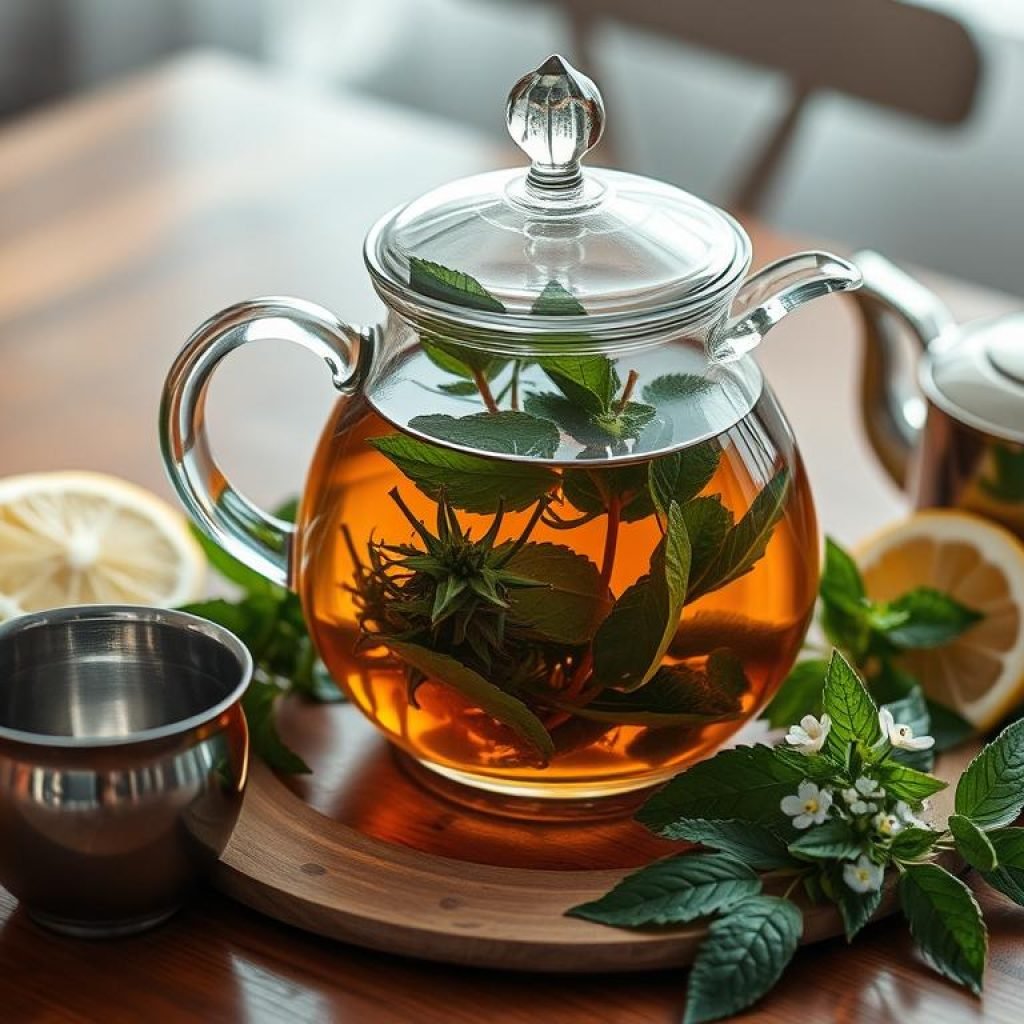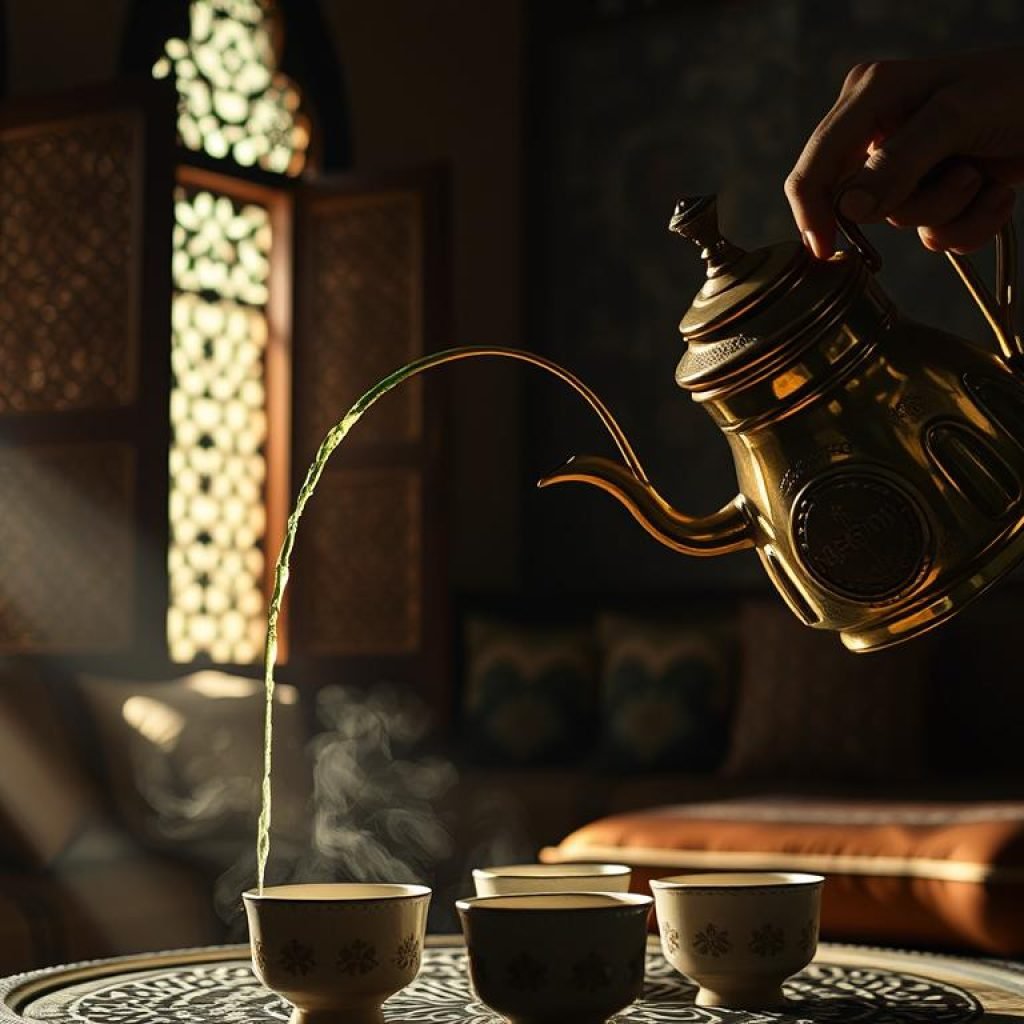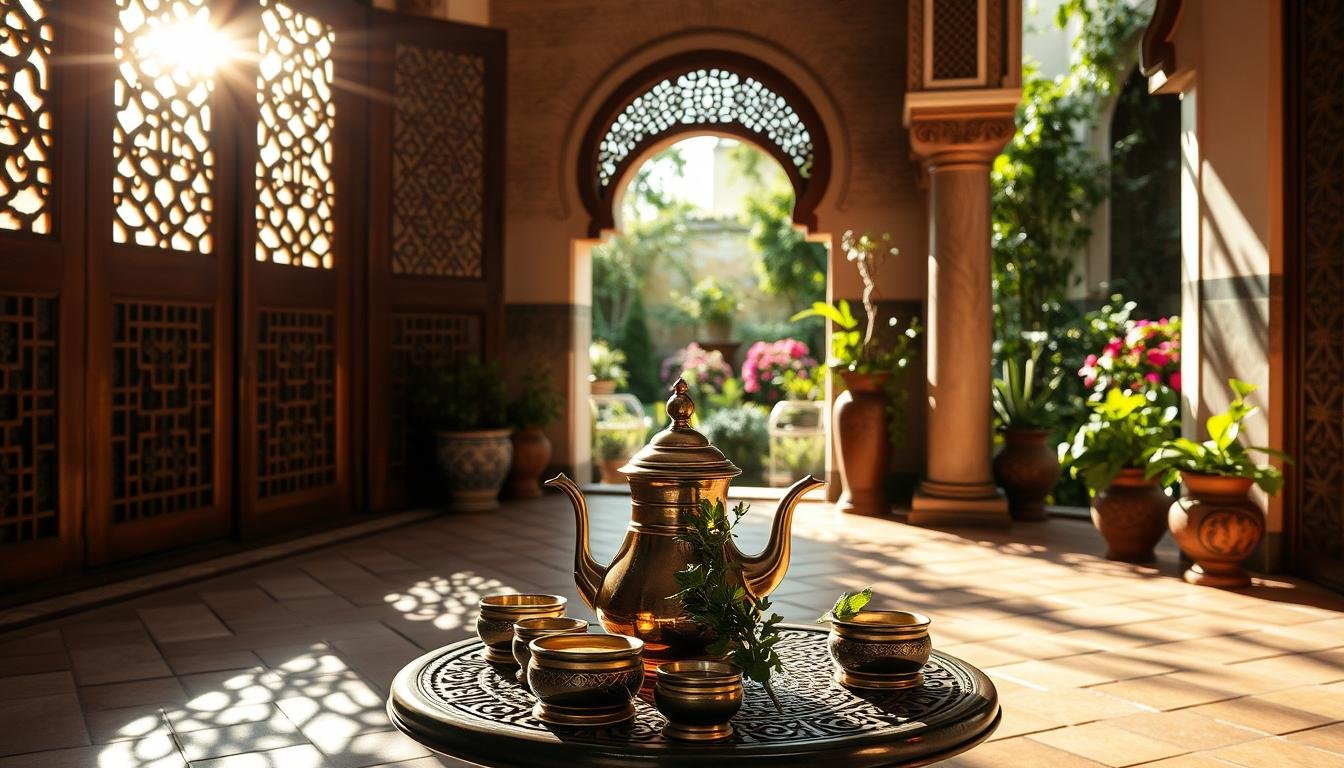What makes Moroccan mint tea so special? It’s the rich history and cultural importance. This tea, made with green tea, fresh mint, and sugar, is a global favorite. It’s served in traditional pottery and enjoyed at social events.
We’ll dive into Moroccan mint tea’s origins, ingredients, and how it’s made. We’ll see its cultural value and how it shows Moroccan hospitality. We’ll also look at the health benefits of drinking it with less sugar.
Introduction to Moroccan Mint Tea
Moroccan mint tea is loved for its strong flavor and refreshing scent. But what makes it so unique? Is it the traditional pottery or its cultural importance in Morocco? As we explore its history and cultural value, we’ll find out why it’s a true cultural treasure.
Key Takeaways
- Moroccan mint tea has a rich history that dates back to the 18th century
- The traditional recipe involves brewing green tea leaves with fresh mint and sugar
- Moroccan mint tea is a cultural staple, often served daily and during special occasions
- The act of serving tea in Moroccan culture signifies respect, warmth, and hospitality
- Reducing sugar in tea can lead to health benefits such as weight management and improved diabetes control
- Alternatives to sugar, such as honey and stevia, are increasingly being used in Moroccan mint tea
Origins of Moroccan Mint Tea
Many are curious about Moroccan mint tea’s origins. The exact history is a bit fuzzy, but it’s thought that European traders brought tea to Morocco in the 1700s. The traditional recipe mixes green tea, fresh mint, and sugar, making a refreshing taste.
This mix has become a big part of Moroccan culture. In fact, mint tea is seen as Morocco’s national drink.
Making Moroccan mint tea is like an art. It uses Chinese green tea, like Special Gunpowder, and lots of fresh mint. Sugar is added to balance the tea’s bitterness, making it sweet and refreshing. The tea is served in small glasses, so you can really enjoy its aroma and taste.
The main ingredients in Moroccan mint tea are green tea, mint, and sugar. These ingredients mix to create a unique flavor that’s both refreshing and energizing. Using top-quality ingredients, like Chinese green tea, is key to a true Moroccan mint tea experience.
In Morocco, mint tea is a big part of the culture and traditions. It’s often served at social events and is seen as a sign of welcome. The traditional Moroccan tea ceremony, called “Atay Naa Naa,” is a big part of the country’s heritage. Making mint tea is a key part of this ceremony.
Cultural Significance
Moroccan mint tea is a big deal in the country’s culture. It stands for hospitality and giving. The way it’s made and served is very traditional, using special pottery and tools.
This tea is key at social events like weddings and festivals. It’s a big part of Moroccan life.
The cultural significance of Moroccan mint tea goes back a long way. Serving it shows respect and welcome to visitors. It shows how important hospitality is in Morocco.
The tea is a big part of the country’s social life. It’s a big deal at gatherings.
Symbol of Hospitality
In Morocco, mint tea is more than just a drink. It’s a sign of hospitality and kindness. Serving it is a way to show respect and welcome guests.
Mint Tea Rituals Across Morocco
Mint tea is made and served differently in different parts of Morocco. The north has sweet and refreshing teas, while the south has strong and spicy ones. These traditional ceremonies and gatherings are a big part of Moroccan culture.
| Region | Mint Tea Variation |
|---|---|
| Casablanca | Lighter blends |
| Fez | More robust brews |
Ingredients of Moroccan Mint Tea
Moroccan mint tea is made with just a few key ingredients. These are green tea, fresh mint, and sugar. Gunpowder green tea is often used because of its special flavor and smell.
Fresh mint is crucial for its refreshing and cooling effect. A standard recipe uses 7 fresh mint sprigs. These are mixed with 1 heaped teaspoon of loose gunpowder tea and 500ml of boiling water. Three tablespoons of caster sugar are added to sweeten it, making a total of 400ml of tea.
To make Moroccan mint tea, the gunpowder tea is rinsed twice with half a cup of boiled water each time. This brings out the tea’s unique flavor and aroma. Traditionally, the tea is very sweet, but you can adjust the sugar to your taste.
Some key traits of Moroccan mint tea are:
- Gunpowder green tea as the main tea type
- 7 fresh mint sprigs per recipe
- High sugar content, with 3 tablespoons of caster sugar per 400ml of tea
- A two-step rinsing process for the gunpowder tea
Knowing the importance of Moroccan mint tea ingredients helps us understand its cultural value. It shows us the traditional ways of making this beloved drink.
The Recipe: Step-by-Step Guide
To make traditional Moroccan mint tea, you need a few simple things. You’ll need fresh spearmint leaves, green tea leaves, sugar, and water. The Moroccan mint tea recipe is straightforward and doesn’t need much gear. Here’s how to start:
First, get all the ingredients and tools ready. You’ll need:
- 2 large bunches of fresh spearmint leaves
- 2 teaspoons of gunpowder green tea leaves
- 3 tablespoons of sugar (or to taste)
- 6 cups of water
Then, follow the brewing techniques below:
| Step | Description |
|---|---|
| 1 | Boil the water in a traditional teapot |
| 2 | Add the green tea leaves and let it steep for 3 minutes |
| 3 | Add the fresh spearmint leaves and sugar, and stir well |
| 4 | Pour the tea into small glasses and serve immediately |
With this step-by-step guide, making delicious Moroccan mint tea is easy. Use fresh ingredients and follow the brewing techniques closely for the best taste. Enjoy your Moroccan mint tea recipe and share it with loved ones!

Moroccan Mint Tea and Social Gatherings
Moroccan mint tea is key in social events and celebrations in Morocco. It shows respect and welcome. The tea-making ritual is special, using traditional pottery and utensils.
This ceremony is a conversation starter. It brings people together, creating a sense of community.
In Morocco, celebrations are not complete without Moroccan mint tea. The tea is served in three infusions, each with its own flavor. This tradition is a big part of Moroccan culture.
Tea is drunk up to 20 to 30 times a day. Serving mint tea often ends with Moroccan pastries and a meal, like couscous or tagine.
The importance of Moroccan mint tea in social gatherings is clear in its preparation and serving. The traditional Moroccan tray is often silver or copper. It can have simple designs or be on feet.
The tea is in small cups, for sipping in small amounts. This tradition shows how important Moroccan mint tea is in bringing people together and creating community.
- Serving as a conversation starter and bringing people together
- Being an integral part of celebrations and special occasions
- Fostering a sense of community and respect among guests
Overall, Moroccan mint tea is crucial in social events and celebrations in Morocco. Its unique tradition and cultural importance make it a vital part of the country’s heritage.
Global Influence of Moroccan Mint Tea
Moroccan mint tea has won hearts globally. Its mix of green tea and fresh mint leaves is unique. This tea’s global appeal is seen in fusion recipes that blend Moroccan and international flavors.
The tea’s popularity has sparked many popular variations worldwide. From India’s spicy mint tea to the Middle East’s sweet mint tea, each place has its own twist. Also, artisanal clay creations like handmade tea sets and decorative teapots are common in Moroccan-inspired tea shops.
- Lemon mint tea, which adds fresh lemon juice to the traditional recipe
- Spicy mint tea, which adds cayenne pepper or red pepper flakes for a kick
- Fruity mint tea, which mixes fresh mint leaves with fruits like strawberries or raspberries
These variations, along with the classic recipe, have made Moroccan mint tea a favorite worldwide.
The Health Benefits of Mint Tea
Moroccan mint tea has been a key part of Moroccan culture for centuries. It offers many health benefits. One major advantage is its role as a digestive aid. It soothes the stomach and eases symptoms of indigestion and bloating.
The herbal remedies in Moroccan mint tea, like peppermint and green tea, have anti-inflammatory properties. These can reduce inflammation and boost overall health. Some key health benefits include:
- Relieving symptoms of irritable bowel syndrome (IBS)
- Improving digestion and reducing bloating
- Reducing inflammation and improving overall health
- Providing a natural source of antioxidants
Besides aiding digestion, Moroccan mint tea also helps in reducing the risk of certain diseases. It improves overall well-being. Its health benefits and tasty flavor make it a favorite among those seeking a healthy drink.
The Art of Pouring Mint Tea
Moroccan mint tea pouring techniques are key to the traditional tea ritual. They require a special technique to pour the tea from above. This isn’t just about the taste; it’s also about the vibrant ceramics used to serve it.
The art of pouring mint tea is a skill that needs practice. Getting the perfect rizza (foam) is a matter of pride for the tea maker.
The presentation of Moroccan mint tea is very important. It uses traditional pottery and utensils. The tea is served in small, delicate glasses, and the teapot can handle high temperatures.
The vibrant ceramics used add to the tea ritual’s beauty. Some key elements of traditional Moroccan mint tea presentation include:
- Using traditional pottery and utensils to serve the tea
- Pouring the tea from a height to achieve the perfect rizza (foam)
- Serving the tea in small, delicate glasses
- Using vibrant ceramics to add to the overall aesthetic of the tea ritual

In Morocco, pouring mint tea is more than just about the tea. It’s about the experience and tradition it brings. The traditional presentation of Moroccan mint tea is a big part of the country’s culture. It’s often used to welcome guests and mark special occasions.
By mastering the art of pouring mint tea, one can truly appreciate its beauty and significance. This traditional Moroccan ritual is a treasure to behold.
Variations in Moroccan Mint Tea
Moroccan mint tea is famous for its unique taste and smell. What makes it even more fascinating are the variations found across different areas. The traditional recipe mixes green tea leaves with fresh mint and sugar. However, the sugar amount can change based on personal taste and local traditions.
The sweetness level of Moroccan mint tea varies greatly. Some enjoy it sweet, while others prefer it less so. Also, regional differences greatly influence the tea’s flavor. For example, some areas brew the tea stronger, while others make it more subtle.
Some popular Moroccan mint tea variations include adding citrus or spices. These additions can make the tea’s flavor and aroma even better. Each region in Morocco has its own special way of making this traditional tea.
When it comes to regional differences, how Moroccan mint tea is made and served can change a lot. In some places, it’s served in small glasses, while in others, it’s in bigger cups. These differences show the rich cultural and social diversity of Morocco, making the tea even more interesting.
Modern Takes on Moroccan Mint Tea
Moroccan mint tea has seen a big change in recent years. Many modern takes now use creative ingredients and infusions. This traditional drink now comes in many flavors, like fruits, herbs, and spices.
For example, some recipes add lemon juice or fresh berries. This gives the classic tea a fruity twist. You can learn more about Moroccan mint tea and its cultural importance by visiting Moroccan travel guides.
Creative Ingredients and Flavors
The traditional Moroccan mint tea recipe can be changed in many ways. You can add citrus fruits, ginger, and cinnamon to it. Some popular changes include:
- Adding a slice of orange or lemon for a citrusy flavor
- Using different types of mint, like peppermint or spearmint, for a unique taste
- Adding spices, such as cinnamon or ginger, for a warm and aromatic flavor
Infusions and Innovations
Besides creative ingredients, Moroccan mint tea has also been innovated with infusions. Infusions like rose petals, lavender, and hibiscus add a new twist to the traditional recipe. These infusions make the tea unique and refreshing.
Whether you want to try a new flavor or stick to the traditional taste, there’s a modern take for you.
The Future of Moroccan Mint Tea
Looking ahead, the future of Moroccan mint tea is key. It must balance keeping traditions alive with changing tastes. This balance will shape the Moroccan mint tea future.
Keeping traditions is vital. It lets us cherish the rich history and cultural value of Moroccan mint tea. Yet, new flavors and ingredients offer a chance for growth. By embracing these changes, Moroccan mint tea can stay a beloved part of Moroccan life.
Several factors will shape the future of Moroccan mint tea:
- Changing consumer preferences and tastes
- The rise of new flavors and ingredients
- The importance of sustainability and eco-friendliness
- The role of technology in shaping drinking habits
In the future, we’ll likely see new twists on traditional Moroccan mint tea. Yet, its unique flavor, cultural importance, and role in bringing people together will stay central. By finding a balance between tradition and change, Moroccan mint tea will continue to thrive in Moroccan culture.
Conclusion: A Lasting Legacy
Moroccan mint tea has become a big part of Moroccan culture. It’s a tradition that has stood the test of time. Every sip tells a story of history and hospitality.
From the 7th century to today, this tea has been a symbol of Moroccan welcome. It shows the country’s rich heritage and identity.
Today, Moroccan mint tea is loved by people all over the world. It has made people interested in Moroccan crafts, like pottery. Sharing mint tea has opened doors to cultural exchange.
As new people discover this tradition, it will keep growing. Moroccan mint tea will continue to win hearts, no matter where it’s enjoyed. It’s a timeless part of Moroccan culture.




Comment (0)